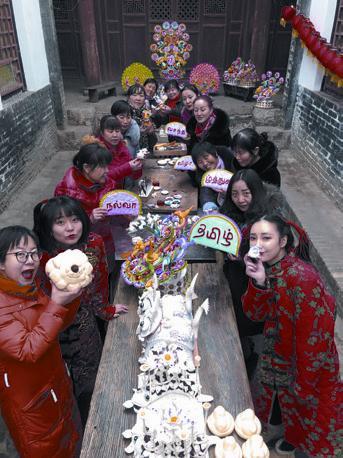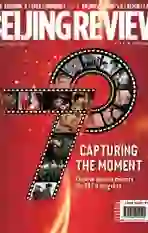From Ni Hao to Vanakkam
2019-11-05BySudeshnaSarkar
By Sudeshna Sarkar
Following tips from a tourist guide 15 years ago, Zhao Jiang went to Mahabalipuram, a town, that despite its architectural splendors, golden beach and performing arts, was strictly off the map for Chinese holiday-goers at the time. Then in October, came the news that Chinese President Xi Jinping and Indian Prime Minister Narendra Modi would have an informal summit at the same seaside resort in the Indian state of Tamil Nadu.
“I was happy that Tamil Nadu got the chance to host the summit and enjoy the spotlight, and I was proud that what I have learned and am working on has now become well-known,” Zhao, who heads the Tamil language service at China Radio International (CRI), said.
It has been an illuminating journey for Zhao. In the mid-1990s, when she went to study a foreign language at the Communication University of China, she chose her major more on a quirk. “At that time, the university was offering Bangla, Nepali, Swahili and Tamil as foreign languages. I knew Bangla was spoken in Bangladesh, Nepali in Nepal and Swahili in Tanzania. But I had never heard of Tamil and I had no idea where it was spoken. So I signed up for this unheard-of language,”she said.
The Great Wall of Tamil
Today, she is an expert in Tamil, the predominant language in Tamil Nadu. It is also spoken in Sri Lanka, Singapore and Malaysia. One of the oldest languages in the world with a history of about 2,100 years, its script is formidable, leading to a noted Indian business tycoon calling it “the Great Wall of Tamil.”
When CRI started its Tamil service in 1963, there were very few Chinese people who spoke the language. One of the fi rst members on the staff was from Sri Lanka and the department started teaching the language to interns.

Zhang Jie, who has a degree in e-commerce, was one of the four interns in 2005. “I wanted to learn Tamil because I wanted to be one of that rare group of people who can speak two of the oldest languages in the world, Chinese and Tamil,” he said. “Our teacher was a fi rst-generation Chinese speaker of Tamil and I learned enough in 14 months to be able to translate from Chinese into Tamil.” Today, the 36-year-old has his own Tamil program on Facebook and is known to his listeners by his Tamil name, Kalaimani, which means a gem of an artist.
The Tamil service was started to introduce China, its culture, economy, technological marvels and the links between the two worlds, not always remembered to the Tamil-speaking world.
“Tamil culture, besides being fascinating, has a long connection with China,”said Sun Qing, one of the 14 Chinese Tamil speakers in the department.
When Chinese navigator Zheng He(1371-1433) set out on his exploratory voyages in the 15th century, he made several stops in southern India, including Mahabalipuram during his third voyage. And much before Zheng, there were trade, diplomatic and cultural exchanges between China and Mahabalipuram, which was a bustling port in the seventh century.
“In Quanzhou City in Fujian, southeast China, you can see the ruins of a Shiva temple. There are inscriptions bearing Tamil characters,” Sun said. Shiva, or the destroyer, is one of the three prime Hindu gods and the temple is believed to have been built in 685 during the Tang Dynasty(618-907).
Sun traveled to the Shaolin Temple in Henan Province in central China, famed for its monks prowess in Shaolin kungfu, on an assignment. “I saw the statue of Bodhidharma outside the temple,” she said, referring to the Indian prince from southern India who lived during the fifth to sixth century. He became a Buddhist monk and traveled to China, where he is said to have propagated Chan Buddhism, also known as Zen Buddhism in Japan.
In its five decades of operation, the Tamil service has branched out into FM programs and new media. In the era of social media, its new focus is videos and platforms like Facebook. Along with Sun, Liao Liang and He Liyuan are CRIs Facebook team of the Tamil service.
A new star
He Liyuan, who uses the Tamil name Nilaani, became an Internet star with her musical rendition of kurals—couplets—from Thirukkural, a Tamil classic collection of over 1,300 couplets on ethics and morality that have had an immense influence on Tamil culture. She said she learned how to sing the couplets on the Internet. What gives her performance a special vibe is the Tamil greeting she uses, vanakkam, and the similarity between what the couplets teach and the teachings of revered Chinese philosophers like Confucius and writers like 11th century poet Su Shi.
One of her renditions from Thirukkural is a couplet that says education is more important than riches. She likened it to Su Shis line Fu you shi shu qi zi hua, meaning a person who has acquired knowledge will appear elegant in whatever he does.
On the occasion of Xis visit to Tamil Nadu, the trio did a brace of Facebook live special programs, highlighting the cultural connections through the arts, food and fi lms.
“Bharatnatyam is a classical Indian dance that comes from Tamil Nadu,” Liao said. “We found a Chinese danseuse living in Beijing who learned the dance in India and is now teaching it to Chinese youngsters with her daughter. She recently invited renowned Indian dancer Leela Samson to Beijing for a workshop and we captured the event to show how close the peopleto-people cultural links are.”
For the food show, He went to Indian Kitchen in Beijing, where with the help of the chef from Tamil Nadu, she poured a batter of ground rice and pulses on a steaming gigantic frying pan in the kitchen to make the Indian delicacy known as dosa, a type of pancake eaten with an assortment of chutneys and a simmering vegetable soup.

“We wanted to show our Tamil audience how close the dosa is to jianbing, a popular Chinese street food where the pancake is made from a batter of wheat and grain and has a fi lling of eggs and sauces,” she said. “We are connected by food as well.”
Suns project meant a trip to Hengdian in Zhejiang Province of east China, famed for its sprawling film studio. There she presented scenes from Chinese martial arts movies interspersed with visuals from a popular Tamil science fiction action film, Robot.2 that was screened in Chinese theaters in September. And while she hosted the program, to the delight of fans, she was accompanied by a lifesize cutout of Rajnikanth, the Tamil superstar, who plays the scientist in the fi lm that creates a humanoid robot.
The special program culminated in the China Meets India event in Chennai, capital of Tamil Nadu, during Xis visit where the CRI team met their Tamil fans and presented them with mementos from China.
So whats next for the Tamil service? “We have just finished the Tamil translation for a special video on the 70th anniversary of the founding of the Peoples Republic of China,”Zhao said. “Thats going to be one of our new programs.”
